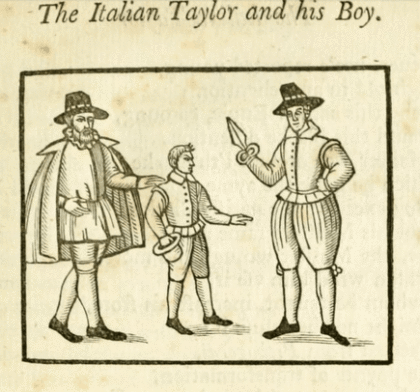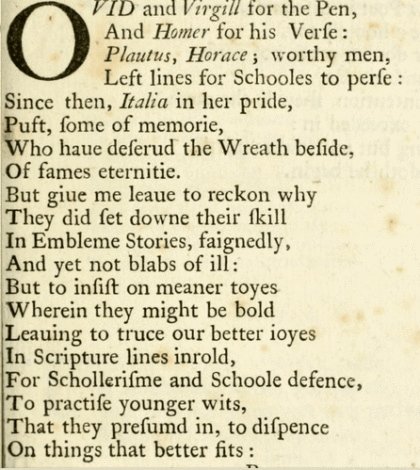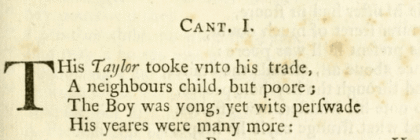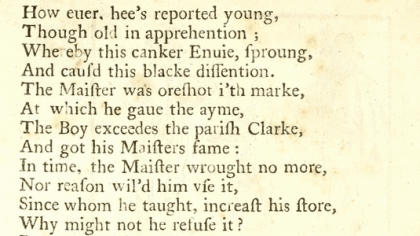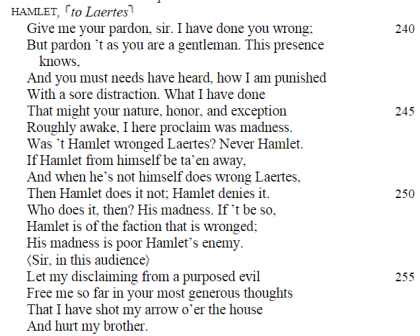Posts from — March 2015
Orefhot i’th Marke
Today’s topic is Robert Armin’s The Italian Taylor and his Boy. Armin’s role as an actor in the King’s Men, and likely originator of the role of Touchstone in As You Like It is well known. Oxfordians are also aware of the evidence that connects him to Edward de Vere here.
Armin loosely translated an Italian tale, a novel from Straparola into verse. As usual we are building on work from Rambler, and he in turn builds on work from Penny McCarthy’s important book, Pseudonymous Shakespeare. That book is available (though expensive) from the links on the left of the page. It belongs in every authorship library. Please read Rambler’s commentary on Armin’s Taylor here, and please follow his link to the short reference in McCarthy as well, also linked here.
Taylor contains two dedications, and a prologue and an argument before the verse gets underway. McCarthy and Rambler have covered the connection between Macaenas as a likely pointer to Shakespeare in the prefatory material, as well as other points including the Vere markers torch and tapers. To their observations, I’ll add the following.
Here Armin is equating the two meanings of bombast. It is the stuffing a tailor uses to fluff our a garment, as well as the that which a writer uses to “line his leaves with railing rethoricke.” Armin is cluing us in ahead of the poem to equate the tailor with a writer. Later in the prologue.
The Italians wrote “Embleme Stories,“ Armin tells us, “wherein they might be bold“ Emblem is a synonym for allegory. To tell a story allegorically is to have license for boldness and “meaner toyes” that could not be expressed otherwise. We are about to read an allegory about a writer. A modern English translation of the original Italian is here. And here is that synopsis.
The working hypothesis here at The Festival Robe is that Shaksper, beginning as a page to Vere, ultimately usurped his notoriety as an author, possibly taking advantage of the latter’s requirement for anonymity due to his noble rank. We can see the attraction of Straparola’s tale as a vehicle for retelling this story, as it involves an apprentice who learns of his master’s secrets and then ‘devours’ him. Now let’s see how Robert Armin retells this tale.
My contention is that Armin has told the authorship story quite concisely in the first sixteen lines of the poem. Here are those sixteen lines.
There is a massive amount of authorship information in these sixteen lines. We have additional evidence that the Vere/Shaksper relationship began when Shaksper was a young boy. We also learn that Shaksper was considered very smart, far beyond his years and schooling. That fits considering where he ended up in the history books. The “Shakspere was stupid” meme that so many Oxfordians are enamored with needs to be trashed. We learn ‘The Boy exceedes the parish Clarke.” Parish clerks were often unlettered, there was too much demand for the position and not enough literate people to fill it. Shakespeare references an unlettered parish clerk in Sonnet 85, and Armin may be directly alluding to that sonnet, as Shakespeare equates himself with that clerk.
“…I think good thoughts, whilst other write good words,And like unlettered clerk still cry “Amen”To every hymn that able spirit affords,In polished form of well-refinèd pen….”
“In time the Master wrought no more,
Nor reason willed him use it,
Since whom he taught, increased his store,
Why might he not refuse it?”
“The Maifter was orefhot i’th marke
at which he gaue the ayme”
The Master was over shot the mark
at which he gave the aim.
“That I have shot my arrow o’er the house
And hurt my brother.”
March 12, 2015 No Comments

